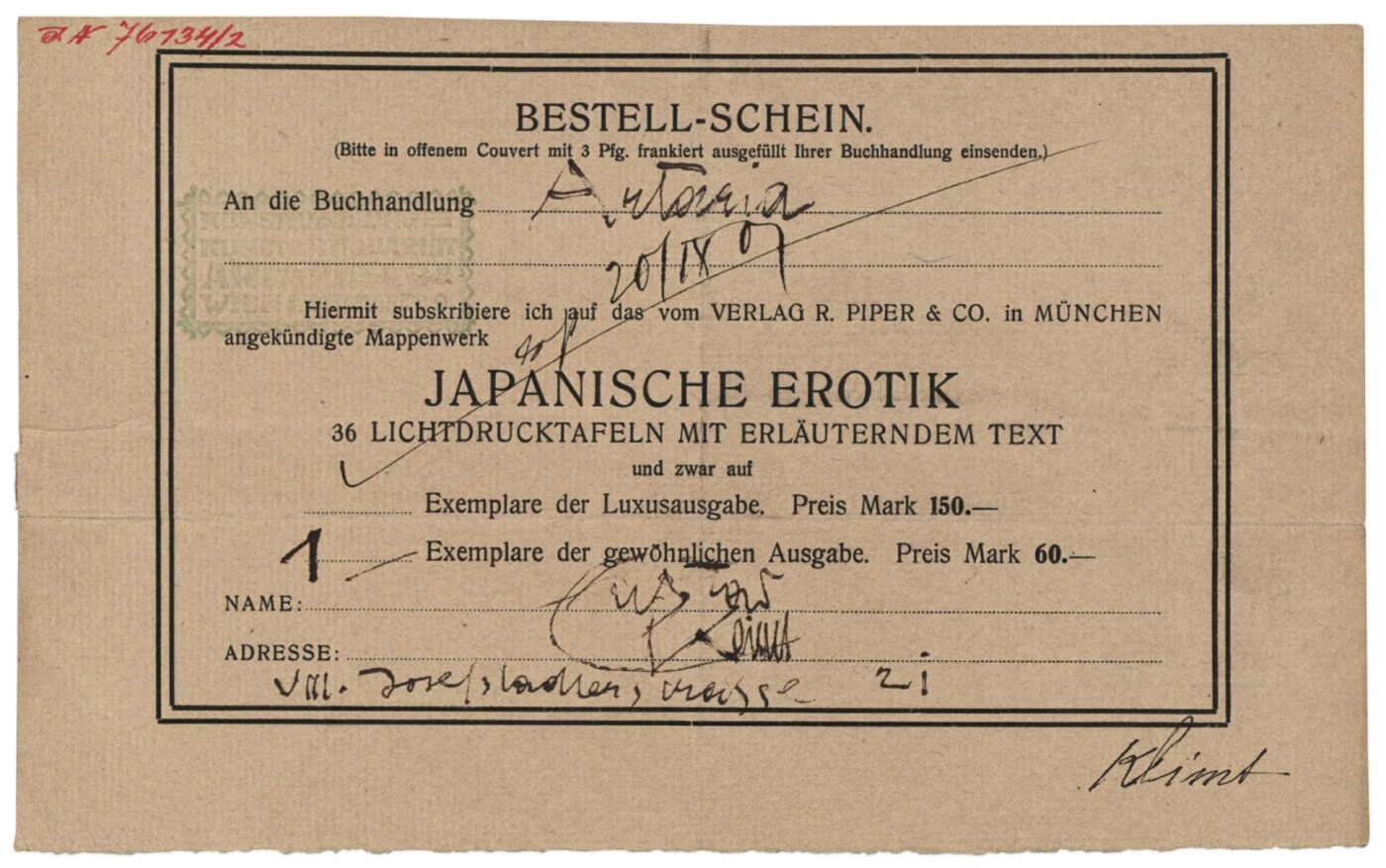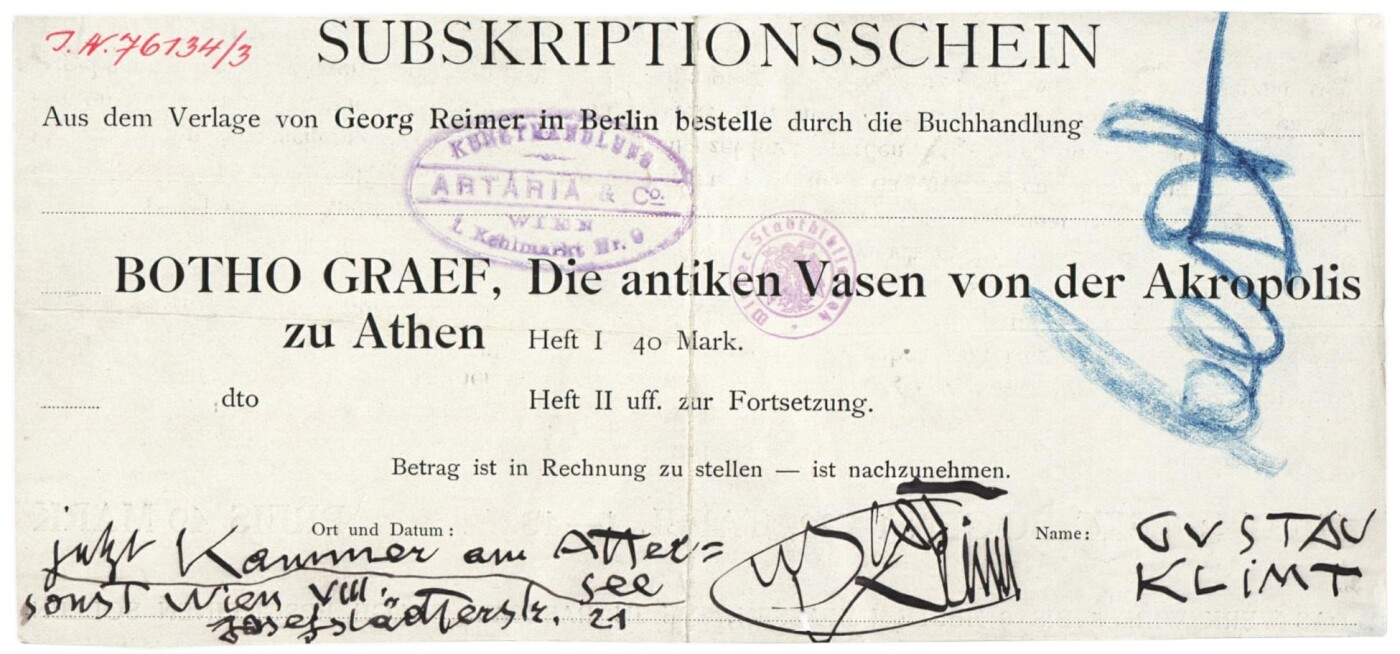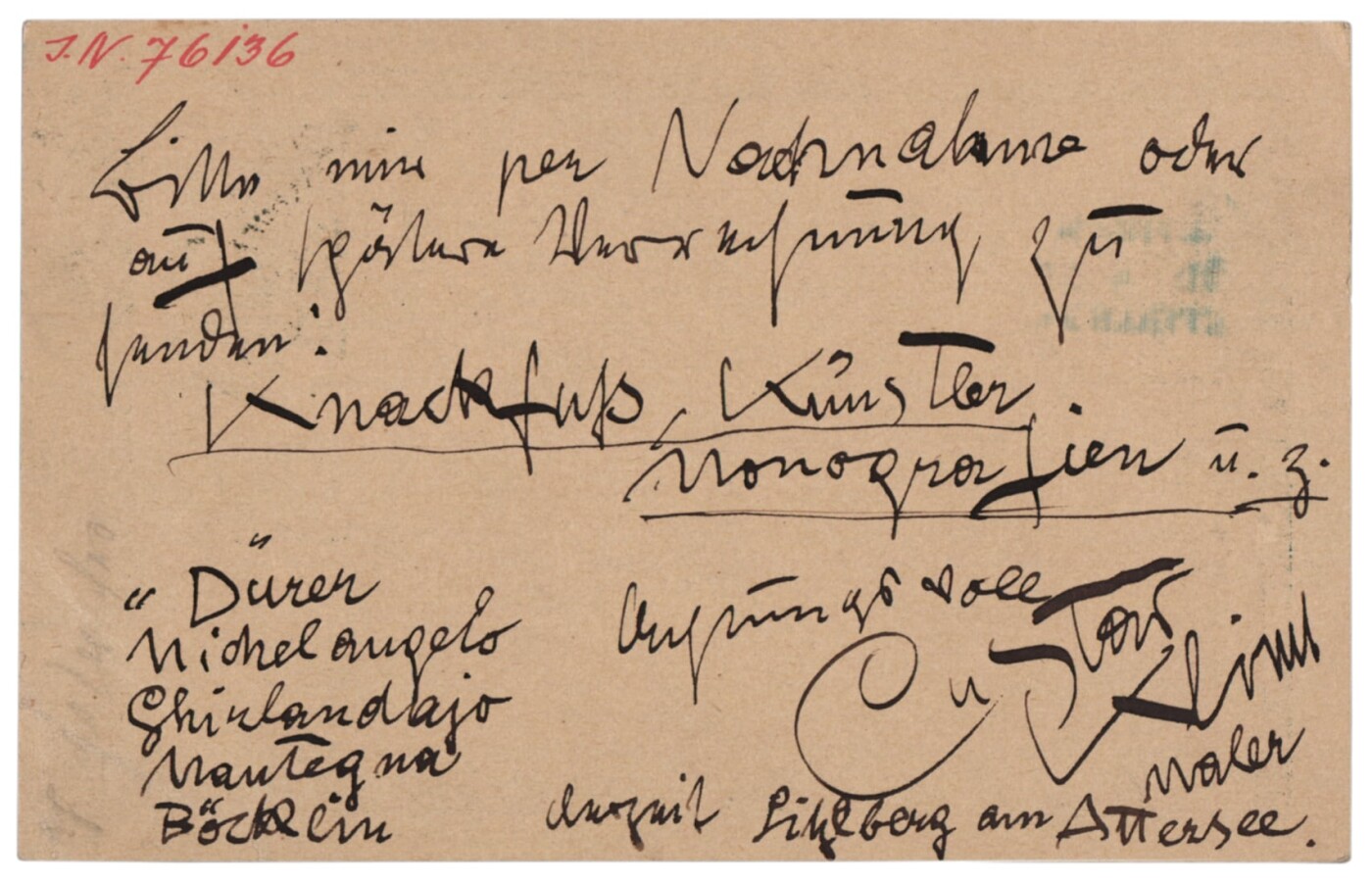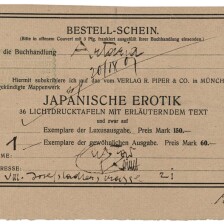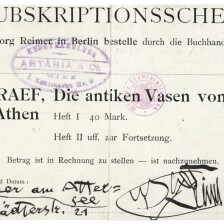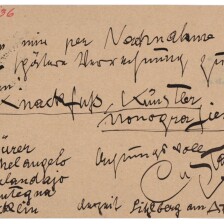Artaria Book and Art Publisher
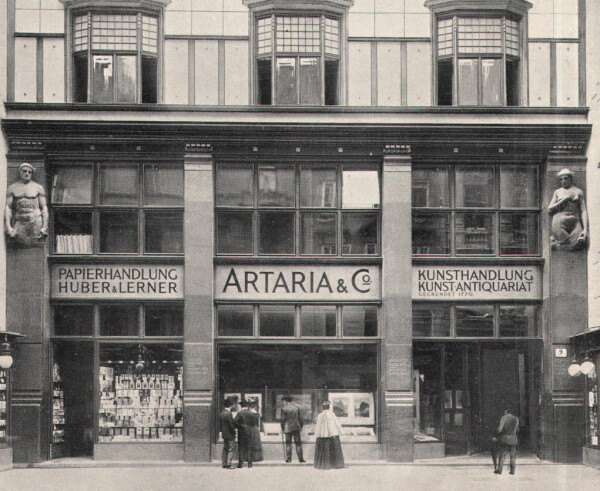
Branch of the book and art shop Artaria & Co at Kohlmarkt 9, in: Der Architekt. Wiener Monatshefte für Bau- und Raumkunst, 8. Jg. (1902).
© ANNO | Austrian National Library
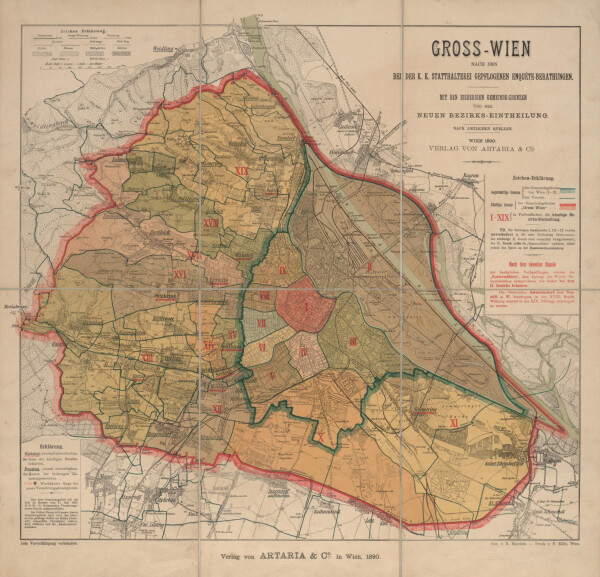
Plan of the city of Vienna, published by Artaria und Compagnie, 1890
© Vienna City Library, Manuscript collection
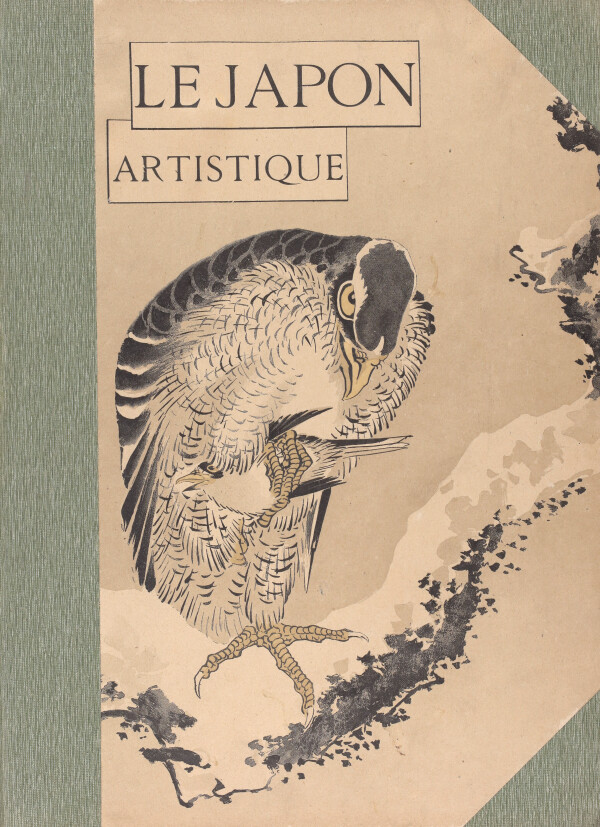
Siegfried Bing (Hg.): Le Japon Artistique, Heft 1 (1888).
© Klimt Foundation, Vienna
Artaria & Co. is considered Austria’s oldest art publisher and one of Vienna’s oldest companies. Besides marketing and publishing writings on art and music and reproductions, the publishing house was particularly known for its high-quality cartographic products.
The history of the art trade and publishing house Artaria & Co. began around 1750 with the Italian brothers Cesare, Domenico, and Giovanni Artaria. As traveling art dealers, the brothers were active all over Central Europe; they finally established a publishing house in Mainz. The next generation, consisting of Francesco and Carlo, settled in Vienna. They registered their company in 1770 under the name of Artaria & Company and were granted the right to trade outside of market areas. From the 1780s, the company had a printing privilege that allowed it to produce cartographic works and printed music.
After moving several times, the company settled in the house “Zum englischen Gruß” [“House of the Angelus”] at No. 9 Kohlmarkt in Vienna’s Inner City (1st District) in 1789. Between 1900 and 1902, the building, commonly known as “Artaria House,” was completely converted by architect Max Fabiani, a member of Otto Wagner’s circle, in the early Viennese Art Nouveau style, and the premises were adapted for exhibition purposes.
Cartographic, Art, and Music Publisher
The publishing house was organized in three divisions. In addition to its cartographic activities, Artaria also established itself as a renowned publisher of music and art. Using the copperplate engraving process and, later on, the new technique of (color) lithography, the company not only printed sheet music by famous musicians such as Wolfgang Amadeus Mozart, Joseph Haydn, Ludwig van Beethoven, Franz Schubert, and Gioachino Rossini. The art department also published engravings by important graphic artists like Jakob Schmutzer, as well as the first portfolio of the newly founded “Kupferstich-Akademie” [copper engraving academy] (1775/76).
However, Artaria was still best known for its atlases. The publisher’s most important works include the Atlas für Commercielle Lehranstalten (1892) and the Atlas für Handelsschulen (1896).
Klimt and Artaria
Several pieces of correspondence prove that Gustav Klimt was a regular customer of the Artaria art dealership. This certainly also had to do with the fact that Klimt’s bank – Bank- und Wechselhaus M. Gerstbauer – was located in the same building as the art dealer at No. 9 Kohlmarkt, and Klimt must therefore have frequented this address on a regular basis.
He mostly purchased art books, monographs, and magazines from the publishing house. Many of the works purchased from Artaria served as a source of inspiration for Klimt’s art. For example, he ordered Botho Graef’s Die antiken Vasen von der Akropolis, Friedrich Willhelm von Bissing’s Denkmäler ägyptischer Skulptur and Siegfried Bing’s Le Japon Artistique, a magazine about Japanese art. Klimt’s works inc motifs from both Egyptian and Japanese art and from the age of antiquity. The artist might have borrowed many of his motifs from these books.
Klimt’s Orders from Artaria
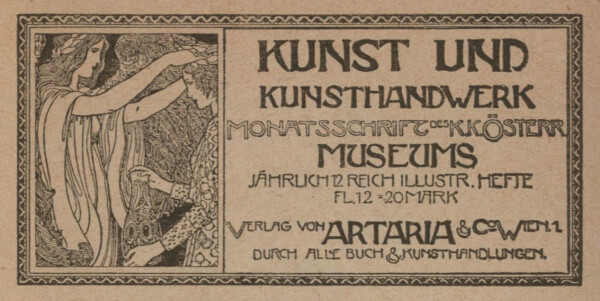
Advertisement for the magazine "Kunst und Kunsthandwerk" published by Artaria Verlag in the catalog of the I. Secession Exhibition, in: Vereinigung bildender Künstler Österreichs Secession (Hg.): Katalog der I. Kunstausstellung der Vereinigung bildender Künstler Österreichs, Ausst.-Kat., Flower rooms of the k. k. Gartenbaugesellschaft (Vienna), 26.03.1898–20.06.1898, Vienna 1898.
© Library of the Belvedere, Vienna
The extent of Klimt’s orders placed with the publisher is shown by his payable invoice from 1914. With an outstanding amount of 2,666 crowns (approx. 15,280 euros), the painter must have purchased a considerable number of books from Artaria.
Liquidation of the Publishing House
Toward the end of the 19th century, the publishing of art engravings was cut down. In 1894, the music publishing division was sold to Josef Weinberger. In 1920, G. Freytag & Berndt took over Artaria & Co.’s remaining cartographic department as a subsidiary. The new name was Freytag-Berndt & Artaria KG, Kartographische Anstalt. In 1922, the art department of the publishing house entered into a partnership with the art dealer Gustav Nebehay; the art dealership Artaria & Co. was nevertheless dissolved shortly afterwards, in 1931.
Literature and sources
- Wien Geschichte Wiki. Artaria. www.geschichtewiki.wien.gv.at/Verlag_Artaria (05/18/2020).
- Wien Geschichte Wiki. Berndt & Freytag. www.geschichtewiki.wien.gv.at/Freytag_%26_Berndt (05/18/2020).
- Wiener Zeitung. www.wienerzeitung.at/nachrichten/kultur/mehr-kultur/166025-Ein-Plaedoyer-fuer-das-Klimt-Atelier.html (05/18/2020).
- Murray G. Hall: Österreichische Verlagsgeschichte. Band I. Entwicklung des Verlagsbuchhandels in Österreich bis 1918. verlagsgeschichte.murrayhall.com/ (05/18/2020).
- Österreichisches Musiklexikon online. Artaria. www.musiklexikon.ac.at/ml/musik_A/Artaria.xml (05/18/2020).
- Vereinigung bildender Künstler Österreichs Secession (Hg.): Ver Sacrum. Organ der Vereinigung bildender Künstler Österreichs, 1. Jg., Heft 1 (1898), S. 26.
- Bestellschein von Gustav Klimt in Wien an die Buchhandlung Artaria & Co in Wien (20.09.1907). H.I.N. 76.134/2, .
- Bestellschein von Gustav Klimt in Wien an die Buchhandlung Artaria & Co. in Wien (16.11.1906). H.I.N. 76.134/1, .
- Brief mit Kuvert von Gustav Klimt in Wien an die Kunsthandlung Artaria & Co. in Wien (22.02.1906). H.I.N. 76.135, .
- Brief von Gustav Klimt in Bad Gastein an die Kunsthandlung Artaria & Co. in Wien (13.07.1914). H.I.N. 76.372, .
- Korrespondenzkarte von Gustav Klimt in Litzlberg am Attersee an die Kunsthandlung Artaria & Co. in Wien (29.07.1904). H.I.N. 76.136, .
- Subskriptionsschein von Gustav Klimt in Kammer am Attersee an die Buchhandlung Artaria & Co in Wien (vermutlich um 1906). H.I.N. 76.134/3, .
- Subskriptionsschein von Gustav Klimt in Wien an die Kunsthandlung Artaria & Co in Wien (um 1912). H.I.N. 17.6442, .


